Welcome back to the Cfile Exhibition digest. Think of this as your Covid-friendly buffet of all the best ceramic art exhibitions happening now from all over the world. We hope you enjoy these morsels as much as we do.
King Houndekpinkou Vessels Bloom with New Spout-Lids
PARIS. For Gravite his fourth exhibition at Galerie Vallois, the Franco-Beninese ceramicist King Houndekpinkou presents around thirty otherworldly sculptural vessels. His gallery states:
Covered in spikes, tubes, and reflective glazes—gold, acidic green, sapphire blue, and candy pink—works like Cavilux rose et or and Gravité: point d’ancrage, rythmes et cris (both 2020) represent the hybridization of ancient and modern pottery techniques originating from Japan and western sub-Saharan Africa. Houndekpinkou also mixes clays from Asia, Europe, and Africa, furthering the sense that his works are physical embodiments of cultural cross-fertilization. His pieces are powerful, modern refutations of the stereotypical notion of African arts and culture as being “fixed” in timeless ancestral traditions.
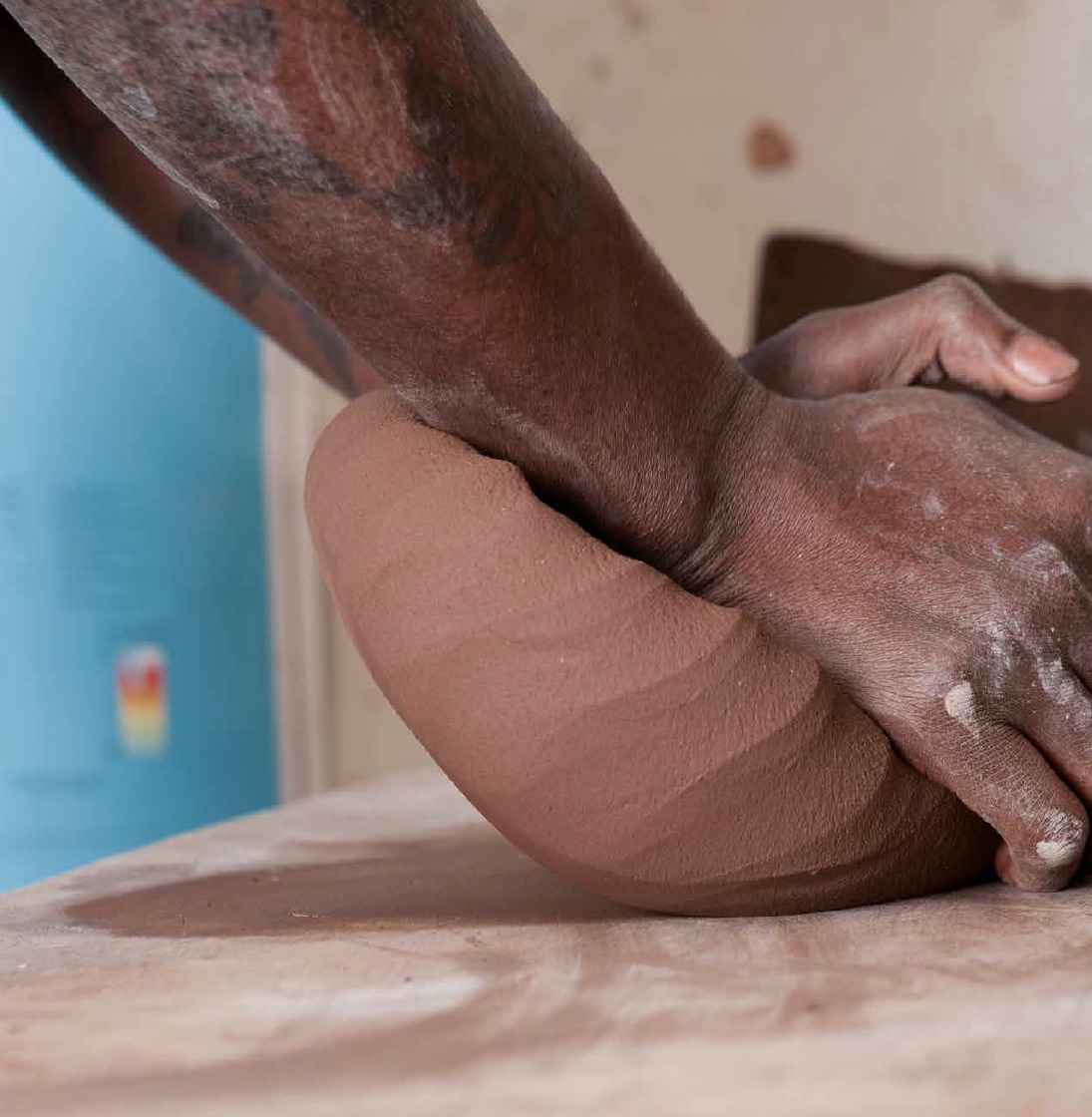

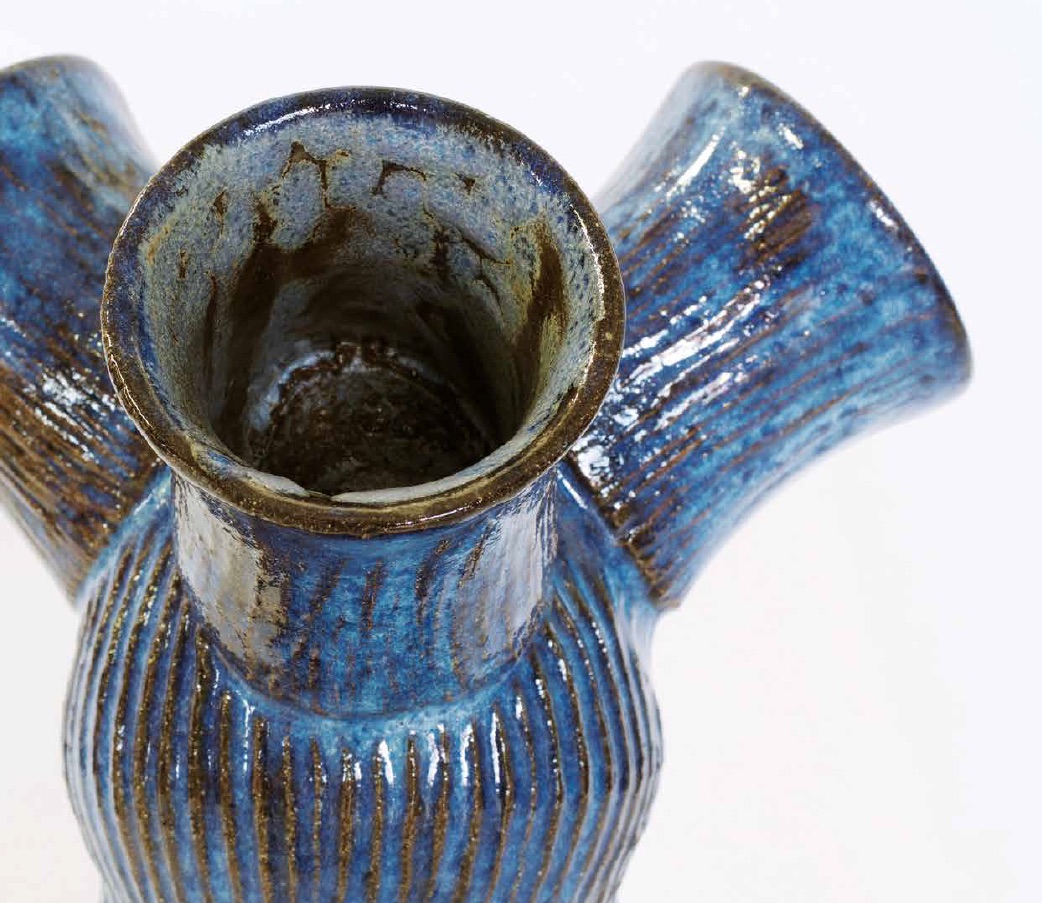
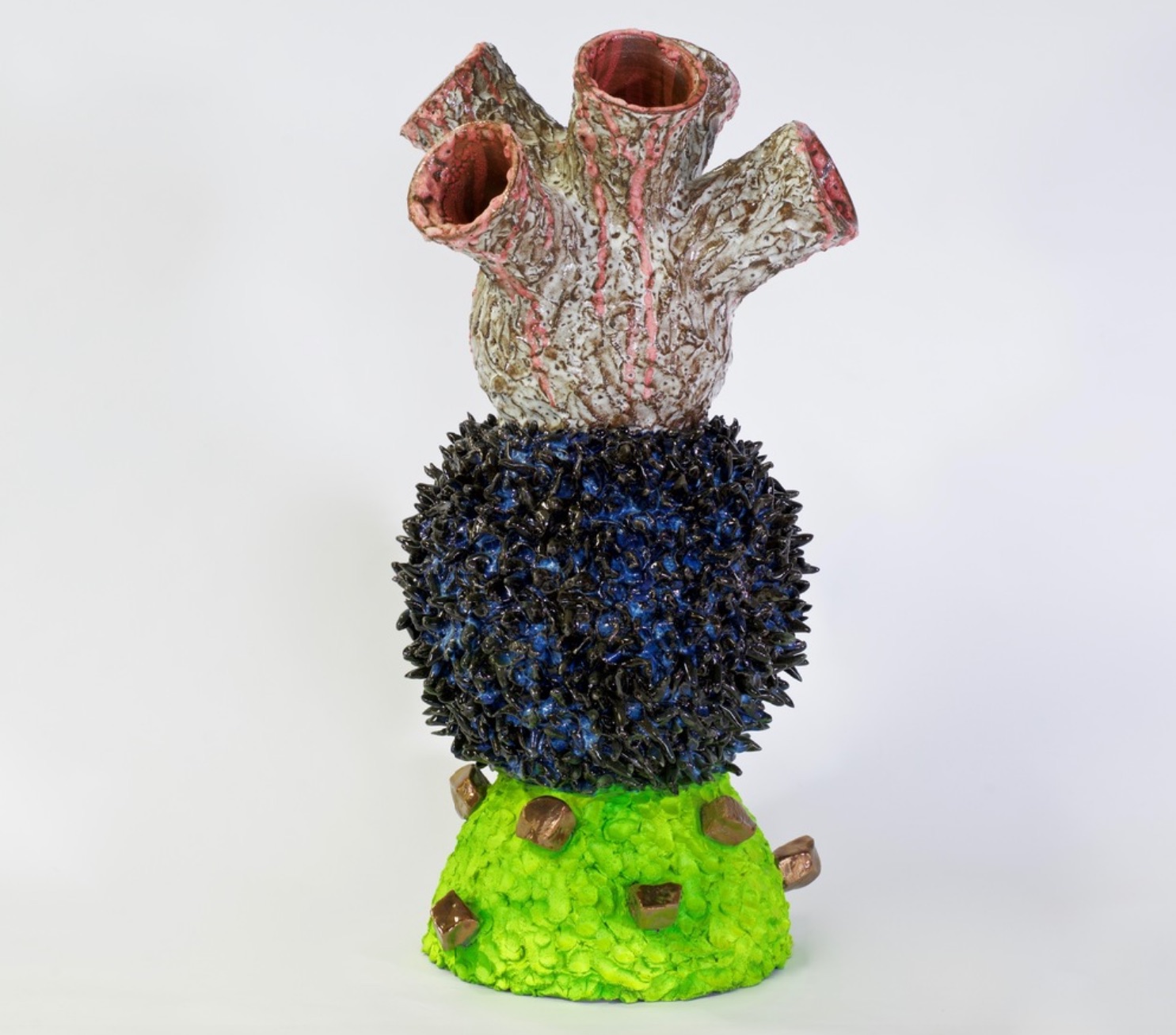

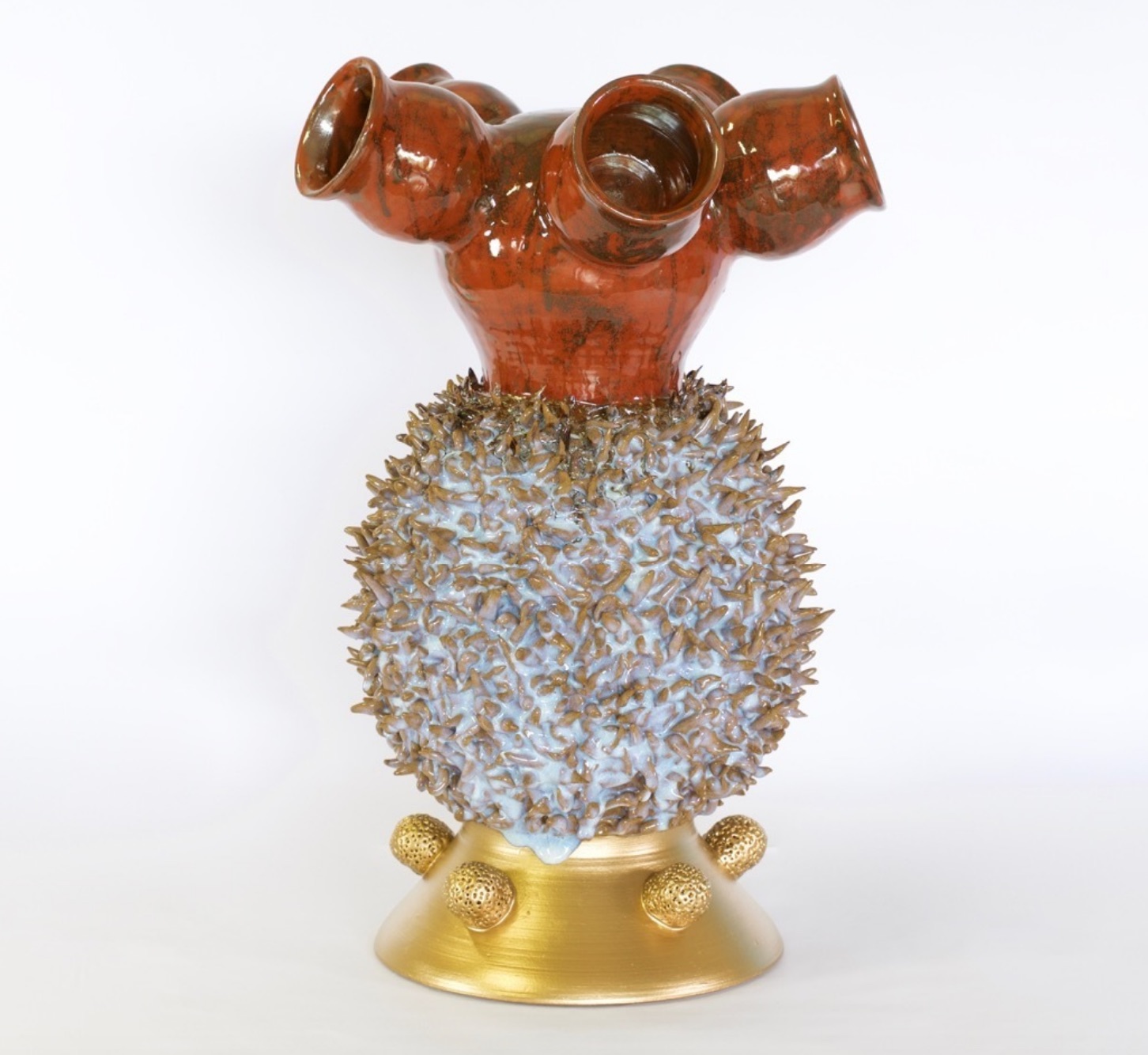

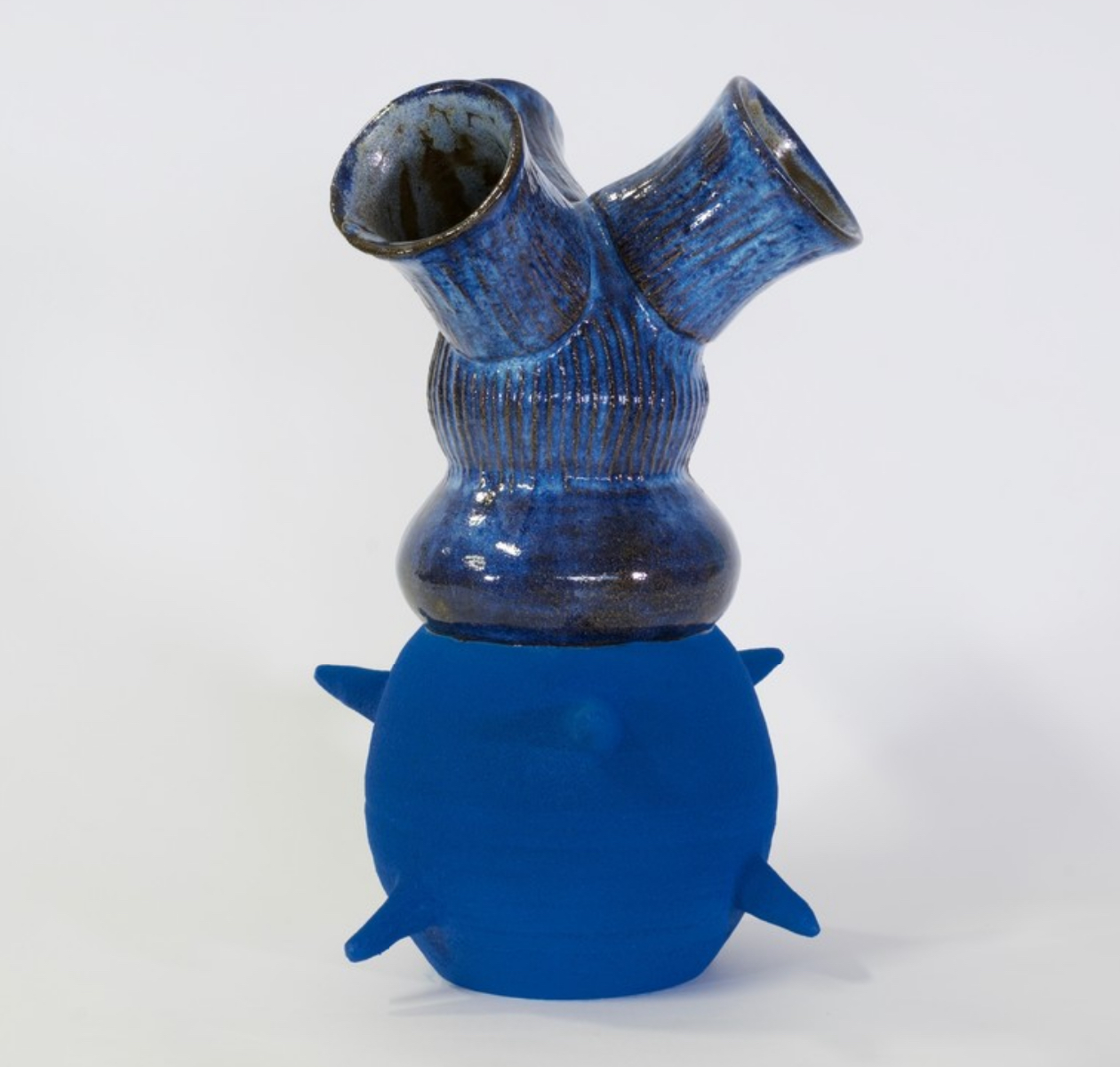









Writer Wilson Tarbox selected Gravite for his survey, 5 Must-See Shows from Paris Gallery Weekend and states:
Houndekpinkou’s approach is at once original, innovative, and yet also (perhaps through his use of bright colors and abstract geometry) connected to a certain “tradition of rupture”—what Francophile Mexican poet Octavio Paz once described as the defining characteristic of modernism.
The show is brilliant in many ways and now includes a development that adds power (and some mystery) to Houndekpinkou’s pots. The spout-lids (are they pulling in or pushing out) may seems a modest step but its impact pushes the viewer into a different zone in which they ask questions about purpose. One quibble, the spout-lids mostly work very well but have difficulty holding their own when their glazes are ordinary and don’t match the sumptuary of the main form. GC
Massive Works in Scale and Substance By Simone Leigh
LOS ANGELES. After recently winning the Hugo Boss Prize Simone Leigh has launched a fittingly ambitious exhibition at the David Kordansky Gallery.
In recent years, Leigh has become increasingly recognized for her large-scale ceramic and bronze sculptures, which feature braided vessels and skirted body-like forms. Rendered at a scale that is often larger-than-life, the stand-alone sculptures are frequently displayed alongside architectural installations.

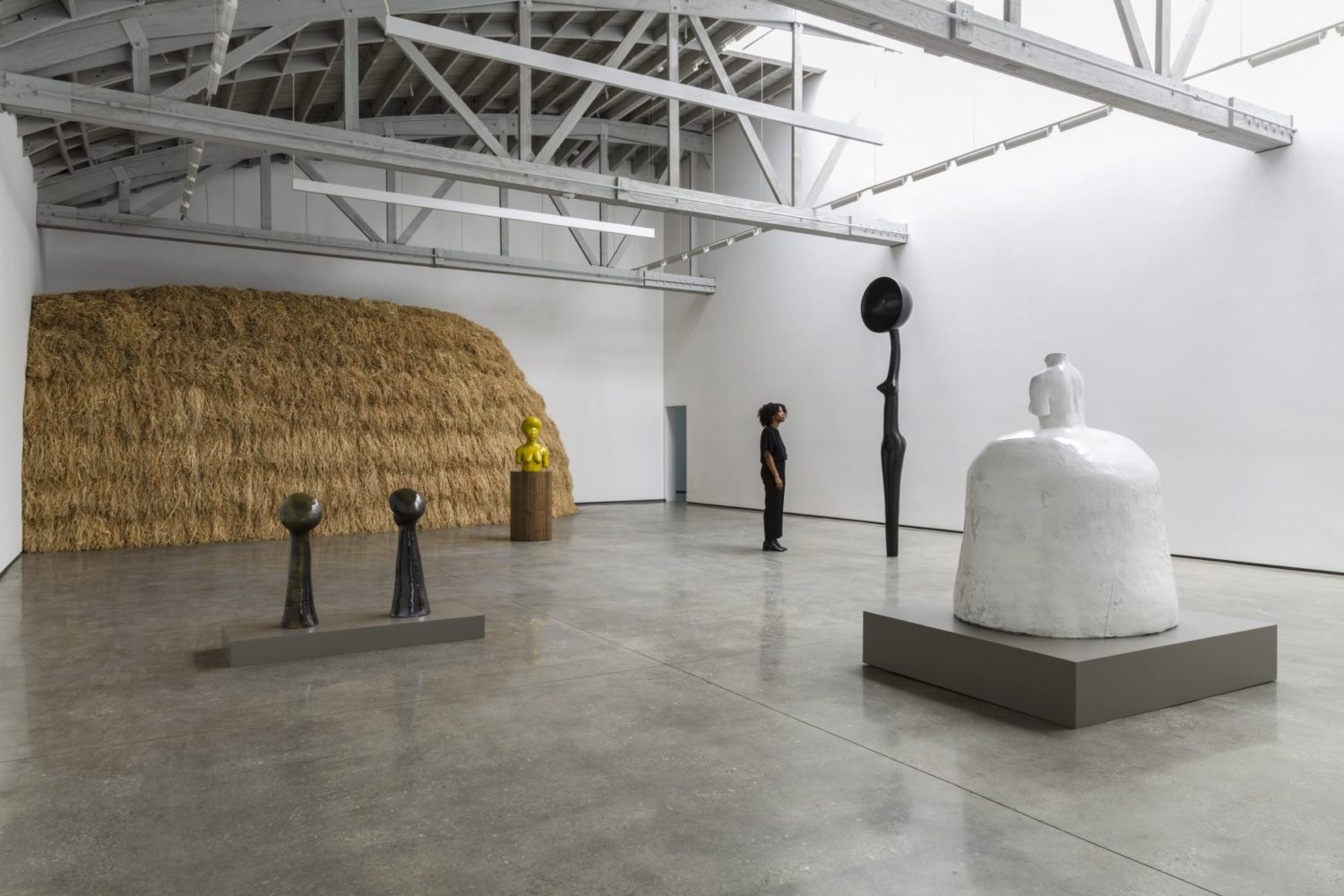
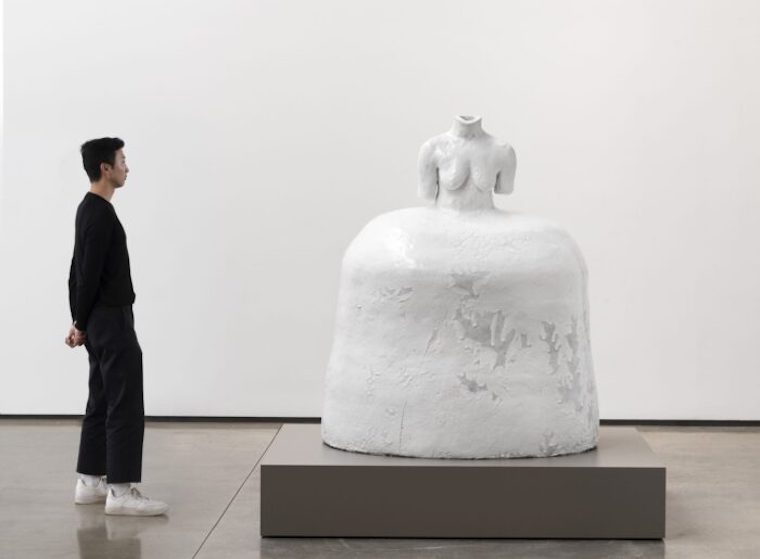
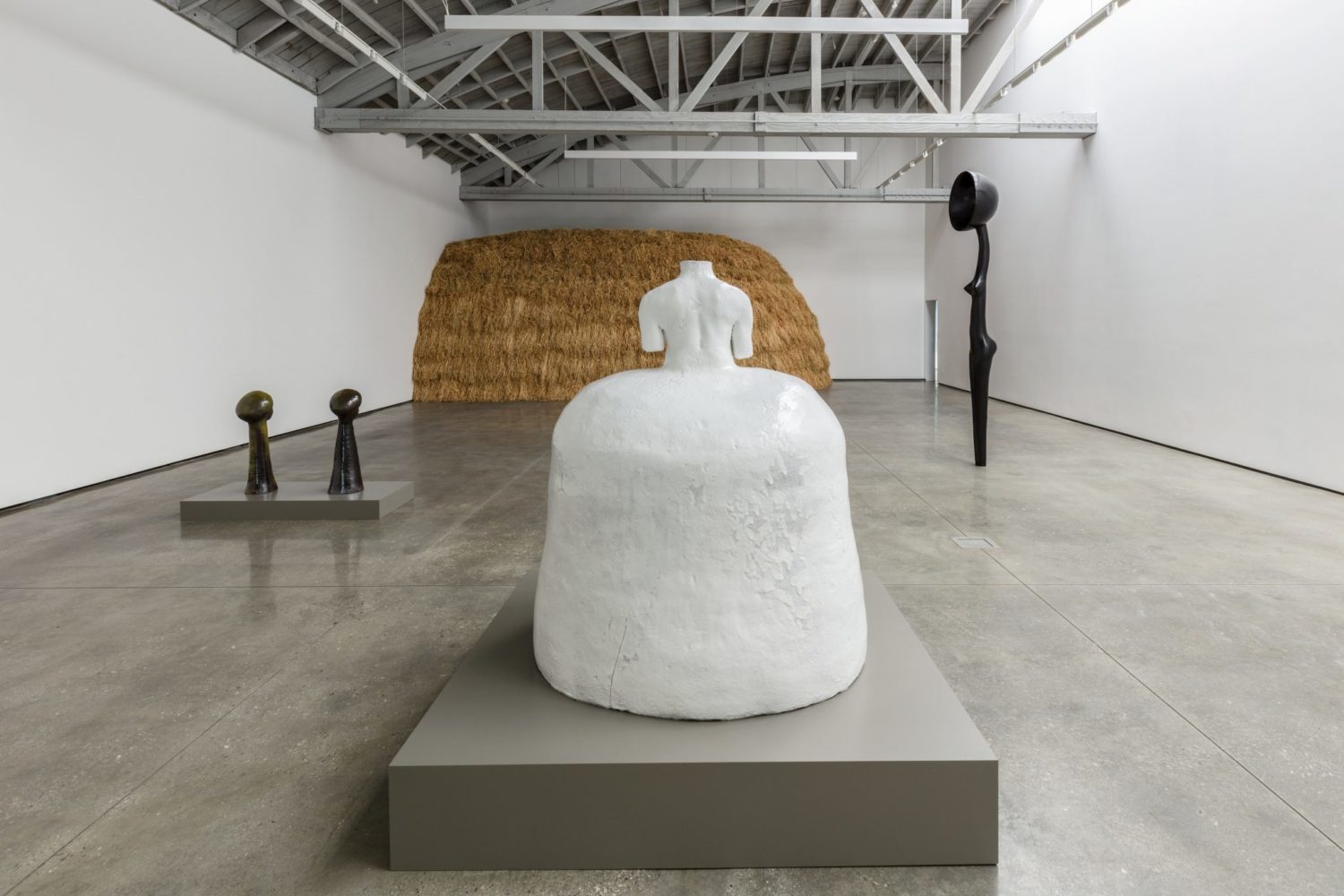
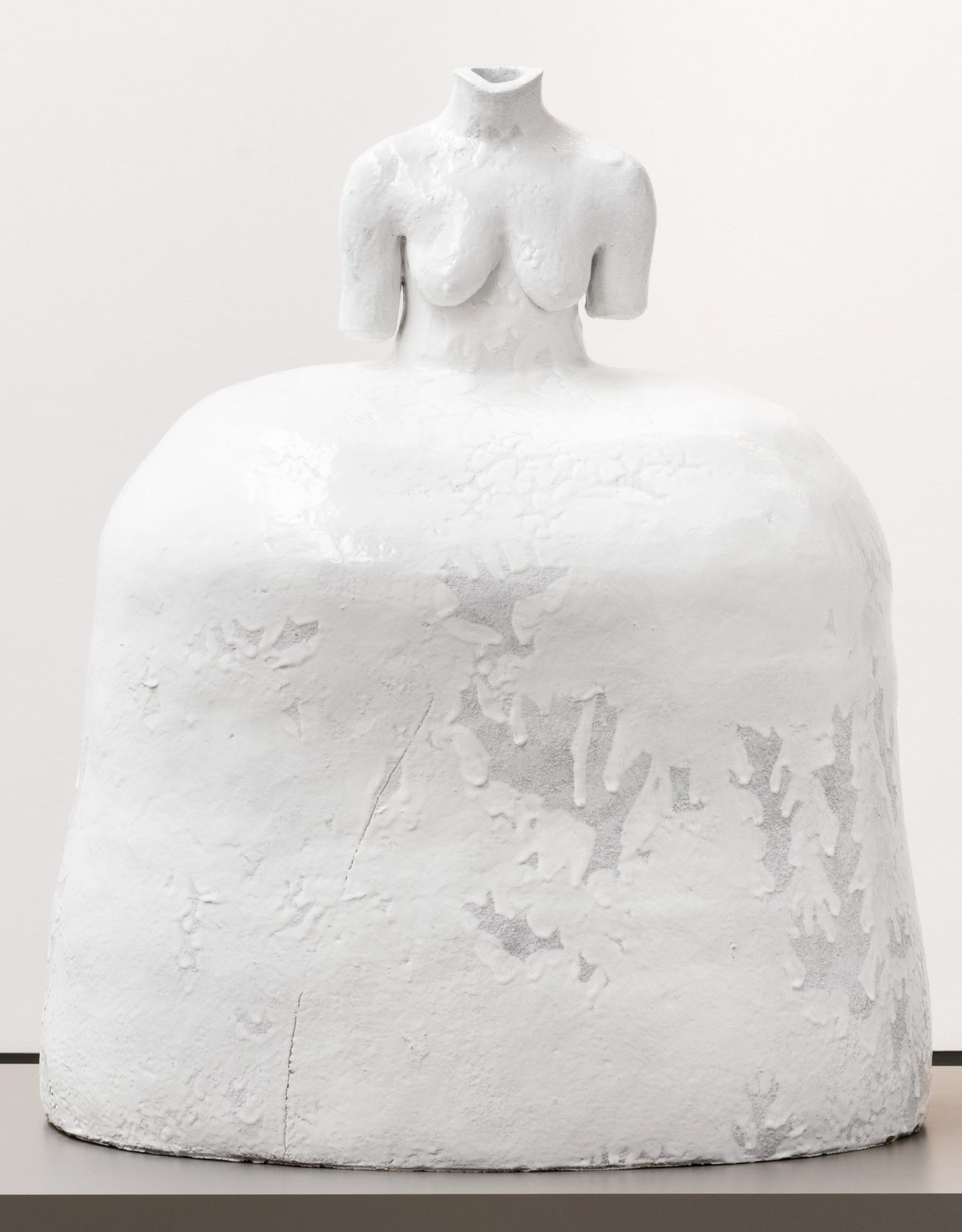




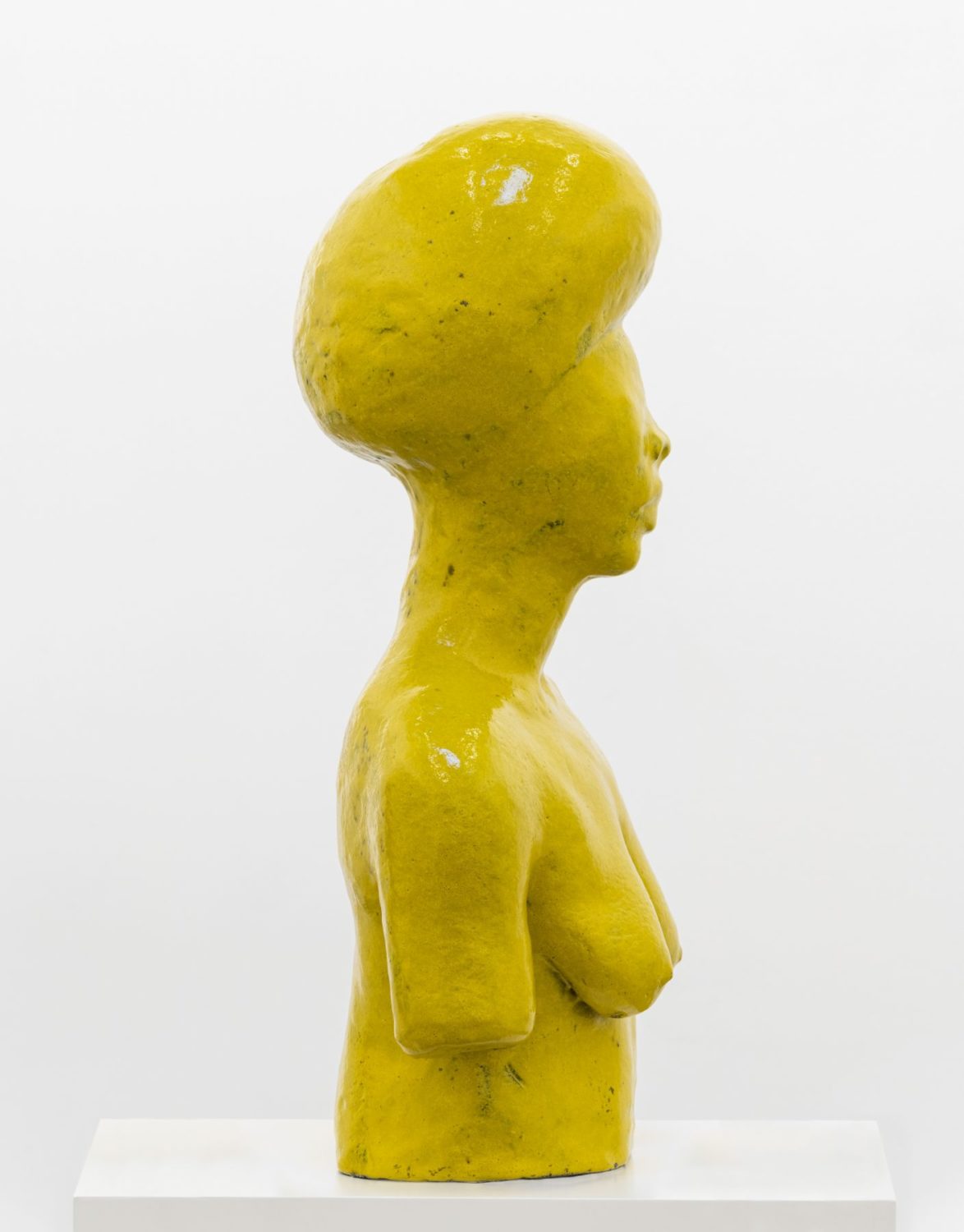
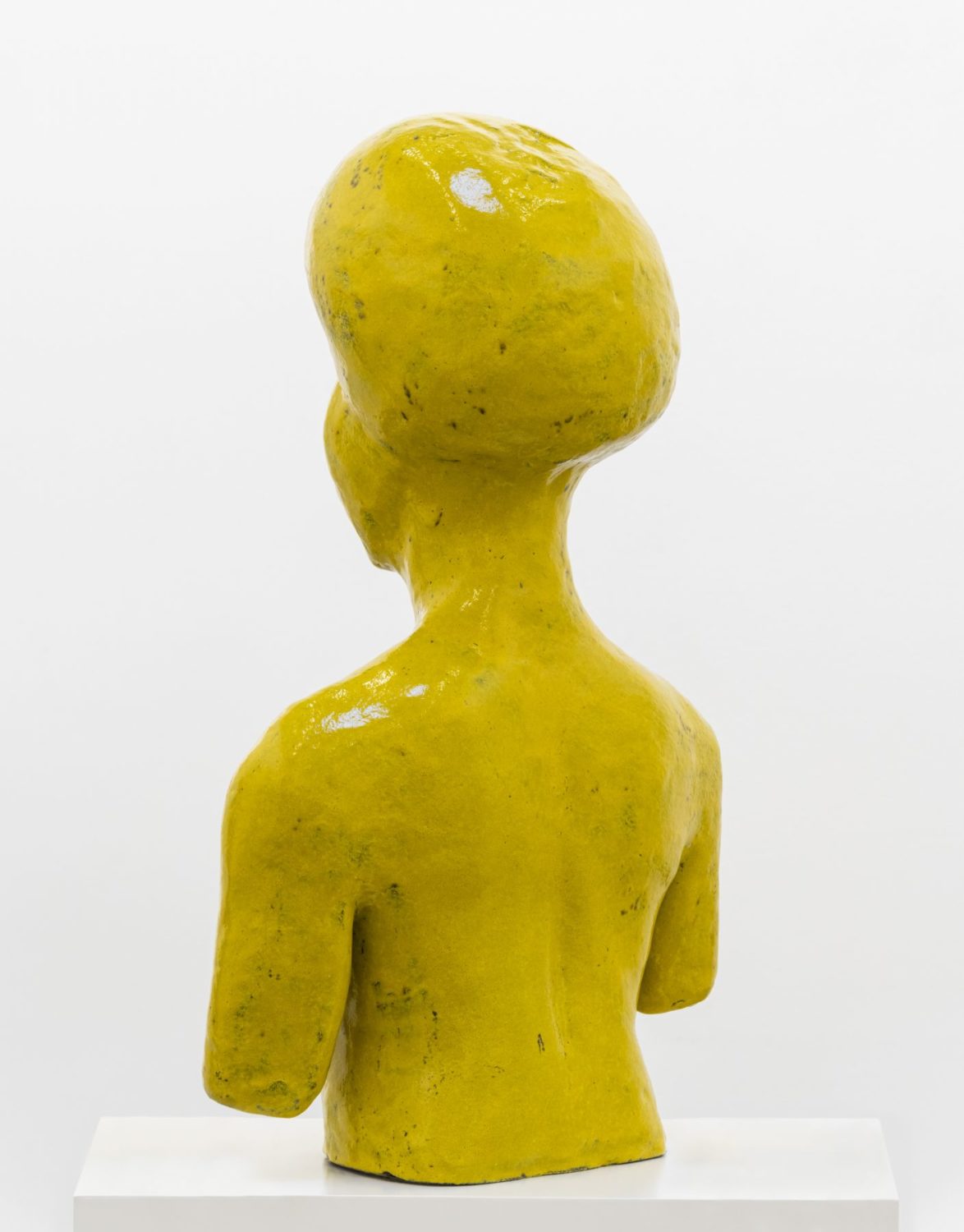












New ceramic sculptures in the exhibition include a bell-shaped figure that is both monumental and intimate. This work can be read in association with the face jug pottery made by nineteenth-century African-Americans enslaved in the South. Leigh’s interest here follows the belief in the sacred value of these vessels, which many believe served as power objects for spiritual protection and the guarding of domestic spaces.
She often incorporates architectural interventions in her exhibitions, as she does here in a large-scale installation that occupies one of the gallery’s corners and a majority of one of its walls. A caged steel frame overlaid with raffia leaves, the work transforms a metaphorical reference to the traditional oval Rondavel grass huts in sub-Saharan Africa or the Mousgoum dwellings in northern Cameroon and Chad into an object that exists somewhere between functional housing and minimalist sculpture. Though there is no door for entry, the form evokes, albeit conceptually, the possibility of communal gathering in a space that otherwise privileges singular acts of viewing.
Read more about this show here.
Text and images courtesy of the artist and the David Kordansky Gallery
Kioshi Kaneshiro Vessels are Explosive in Color and Form
BRUSSELS. Kioshi Kaneshiro, an American artist, has got off to an impressive start. He graduated from Alfred University last year. Do also check out Nick Weddell in Spotted who graduated with Kaneshiro and has also developed impressive momentum in the market. Kaneshiro has shown with several galleries already, starting with Mindy Solomon in Miami.
His exhibition at Puls is not just impressive for the work itself, they are like polychrome hand grenades (excuse the military allusion) just beginning to shatter, which says something about the work’s power. Steve Turner sees a similar quality, “They look as though they were created from an explosion that produced a starburst, a frozen moment, a snapshot of material, time, and heat.”

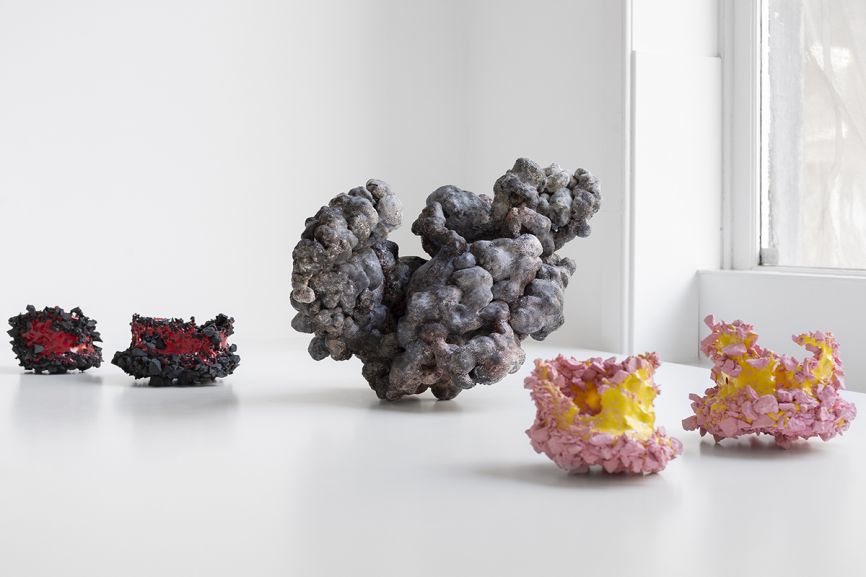
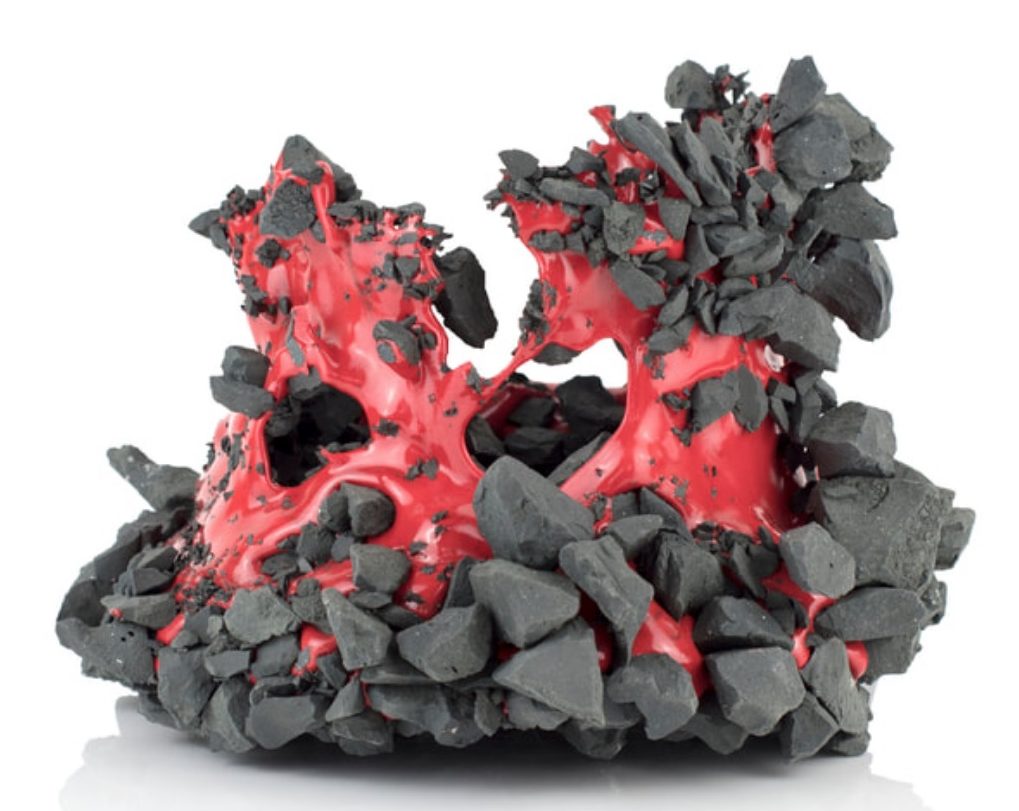




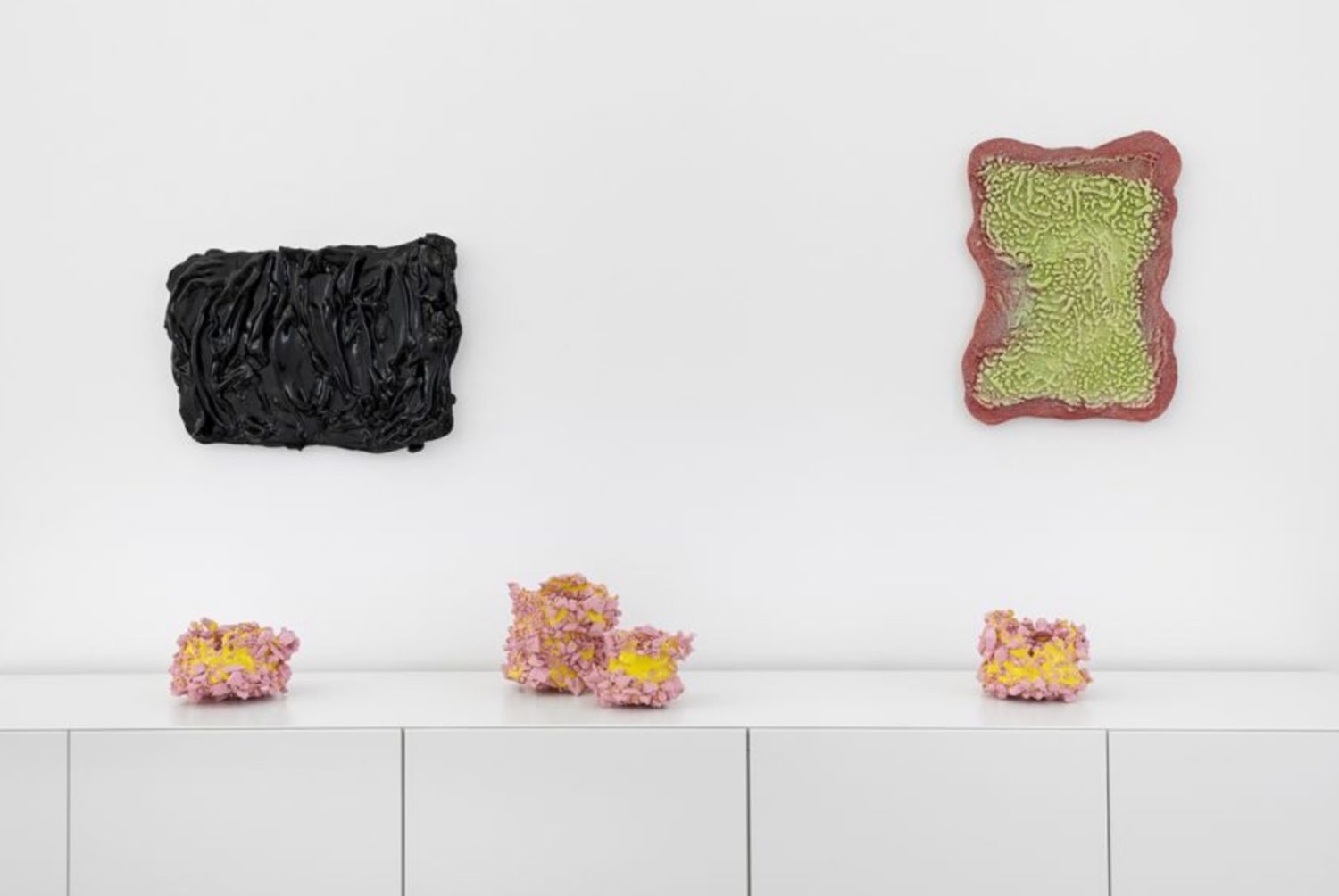









I find the work exciting for another reason. Like many students just graduating, his art was obviously the sum total of his influences, with Katuro Kuwata at the top of the list. In the space of a mere twelve months he has evolved. While influences remain, they are now subsumed. Kaneshiro owns this body of work.
Kaneshiro writes of his practice and his thoughts are, unsurprisingly, not about the hardware of war: “I’ve been thinking a lot about latticework and similar structures in architecture. I’m always super focused in the studio. I know these materials I use really closely. Despite how the work may look I’m very disciplined in process to achieve the aesthetic that the work results in”.
Hikari Ono Makes Small Clay Work for Contemplation
TOKYO. Hikari Ono’s exhibition Object For Painting, 2020, at XYZ Collective is the kind that often sets traditional potters’ teeth on edge. The point is that it is not ceramic (fired) but clay (unfired).
Cfile has been following clay as a parallel but separate road with exhibitions by Urs Fischer, Adrian Villar Rojas, Marc Manders and Anna Maria Maiolino and many other artists. For many ceramists this is cutting corners without the fire and glazes. Buy clay is not absence of fire, it has it its language to offer.

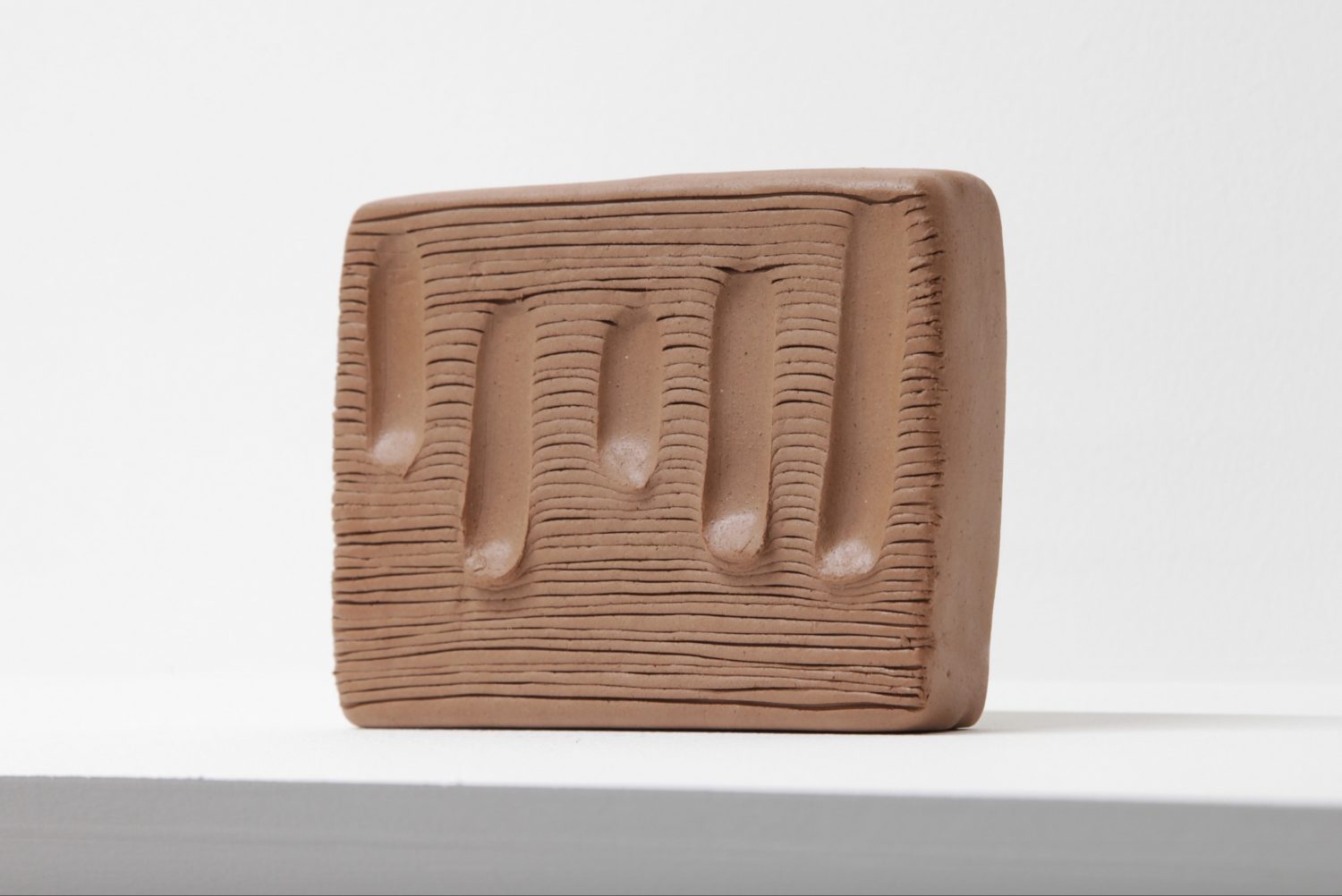

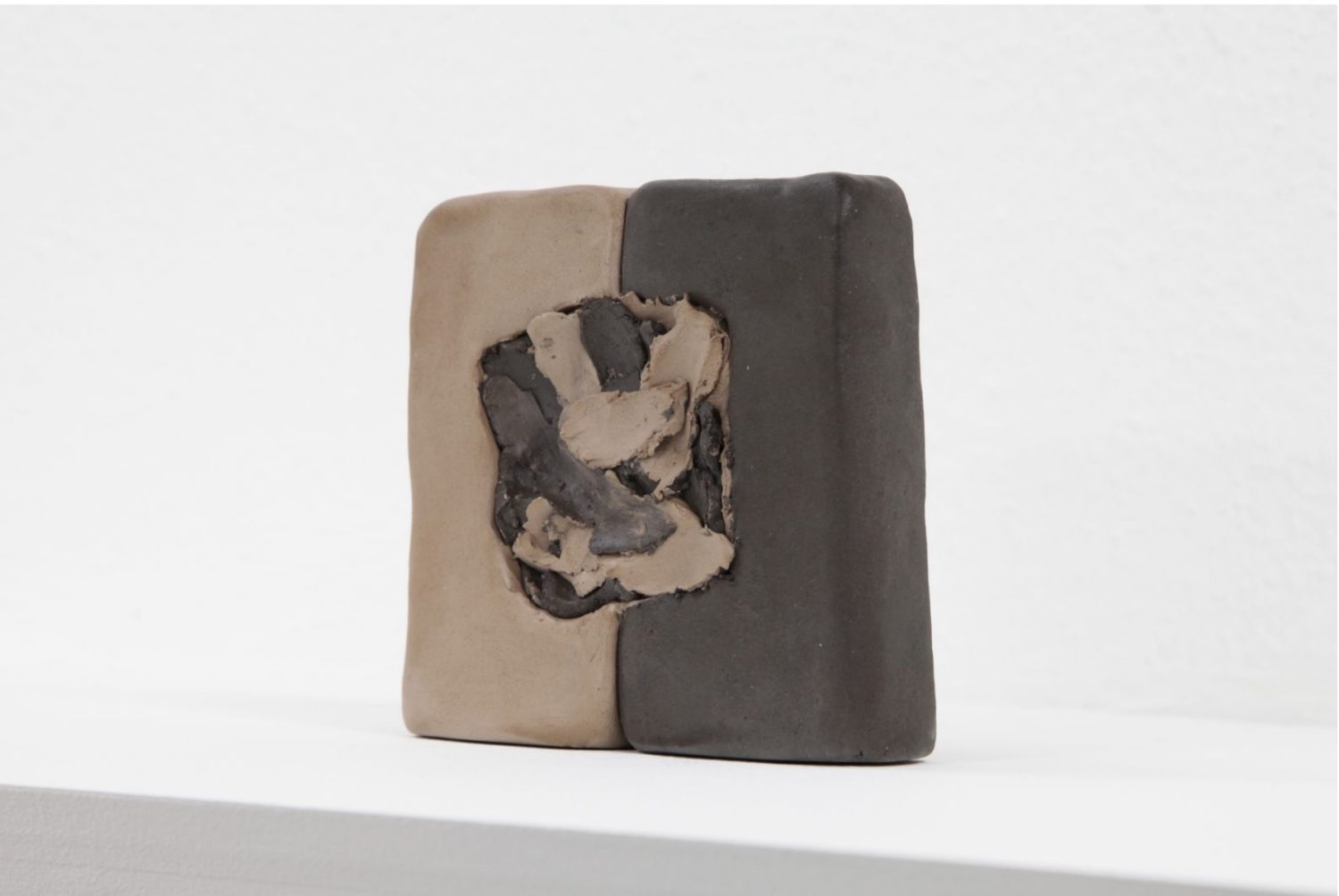









What does Hikari Ono bring to this dialogue? While there is a degree of similarity to the gestural ceramics of Lee Ufan and even a soupcon of Lucio Fontana, her small objects explore a wider range and bring a simplicity of gesture and structure. They are not made for immediate effect bit to be drawn out slowly through contemplation.
Lin Wang Hosts a Dreamscape Dinner
BERGEN. Lin Wang, based in Oslo, Norway has recently held a prerformance dinner artwork at KODE.4 Museum in Bergen. The Dinner titled Exotic Dreams and Poetic Misunderstanding aims to “create a platform for communication where new and old social issues can be brought up in a courteous yet effective manner.
The project constitutes of porcelain artworks inspired by the Eurasian Maritime Silk Road, food and a thematic concert.” Wang describes the her intentions with the work:
The curiosity and imagination of “the other side of the world ” is universal to human beings in ancient and modern times. Maritime activities shaped the histories of the East and the West. Ocean was the first mediator that bridged cultures and connected people.
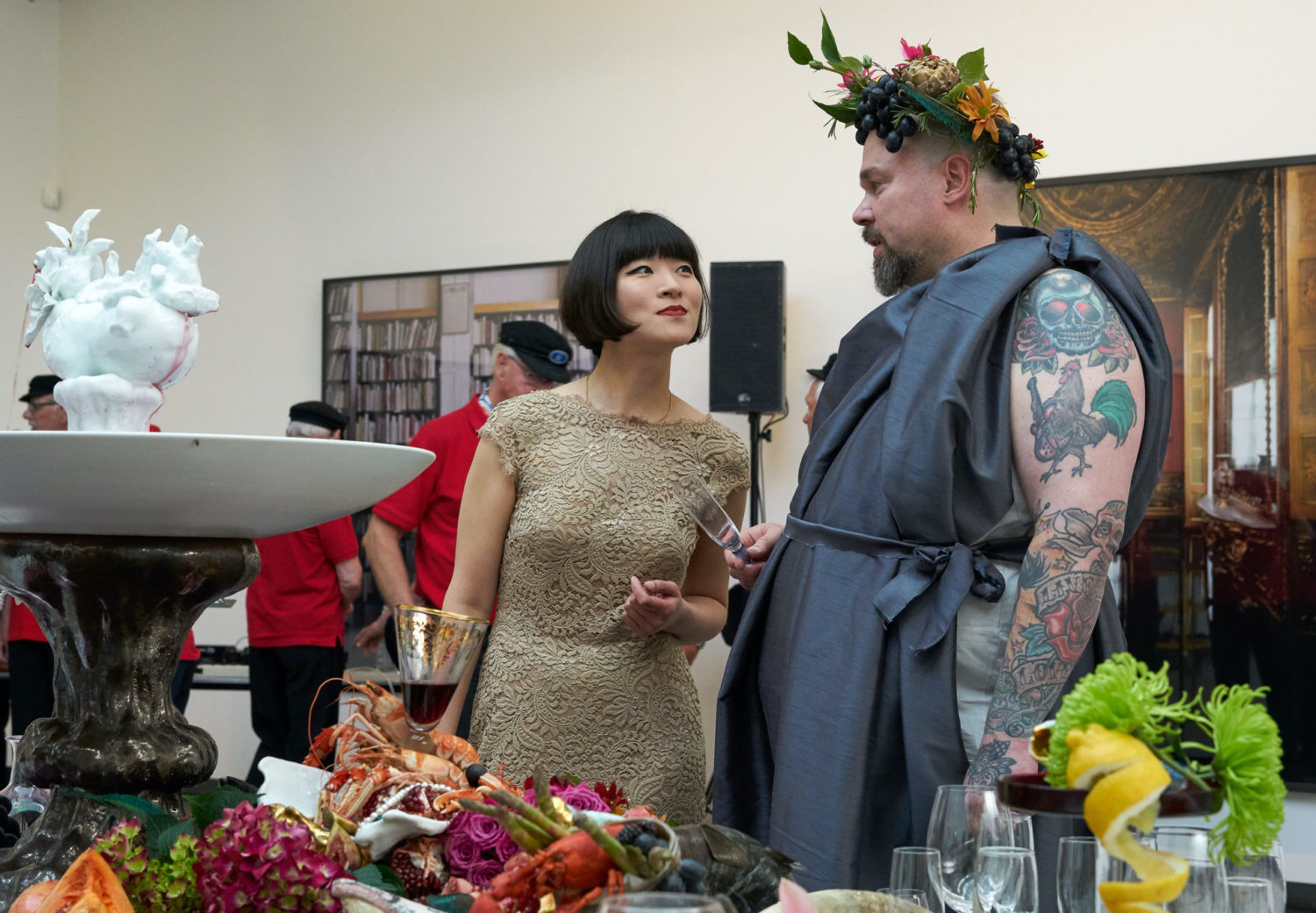


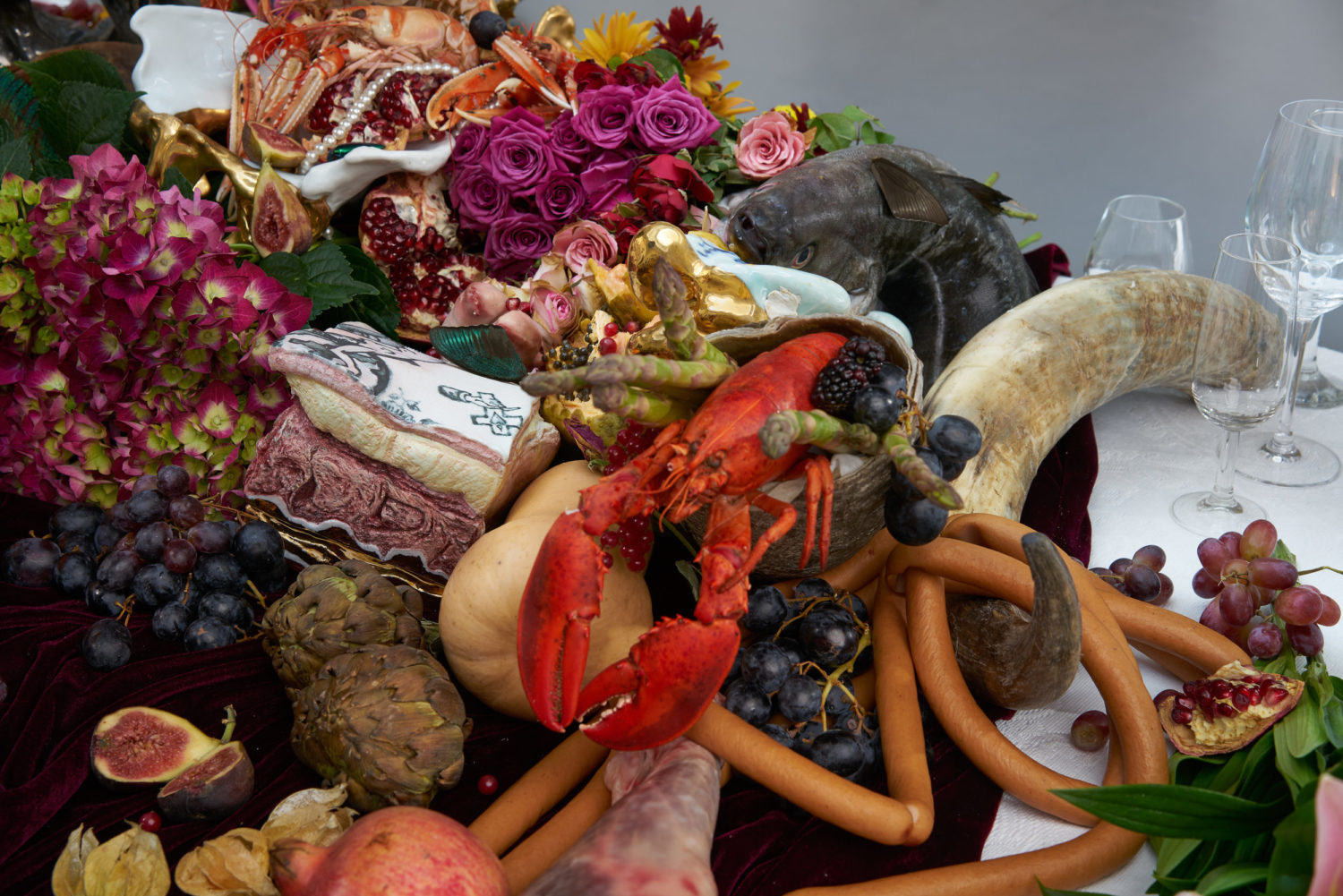
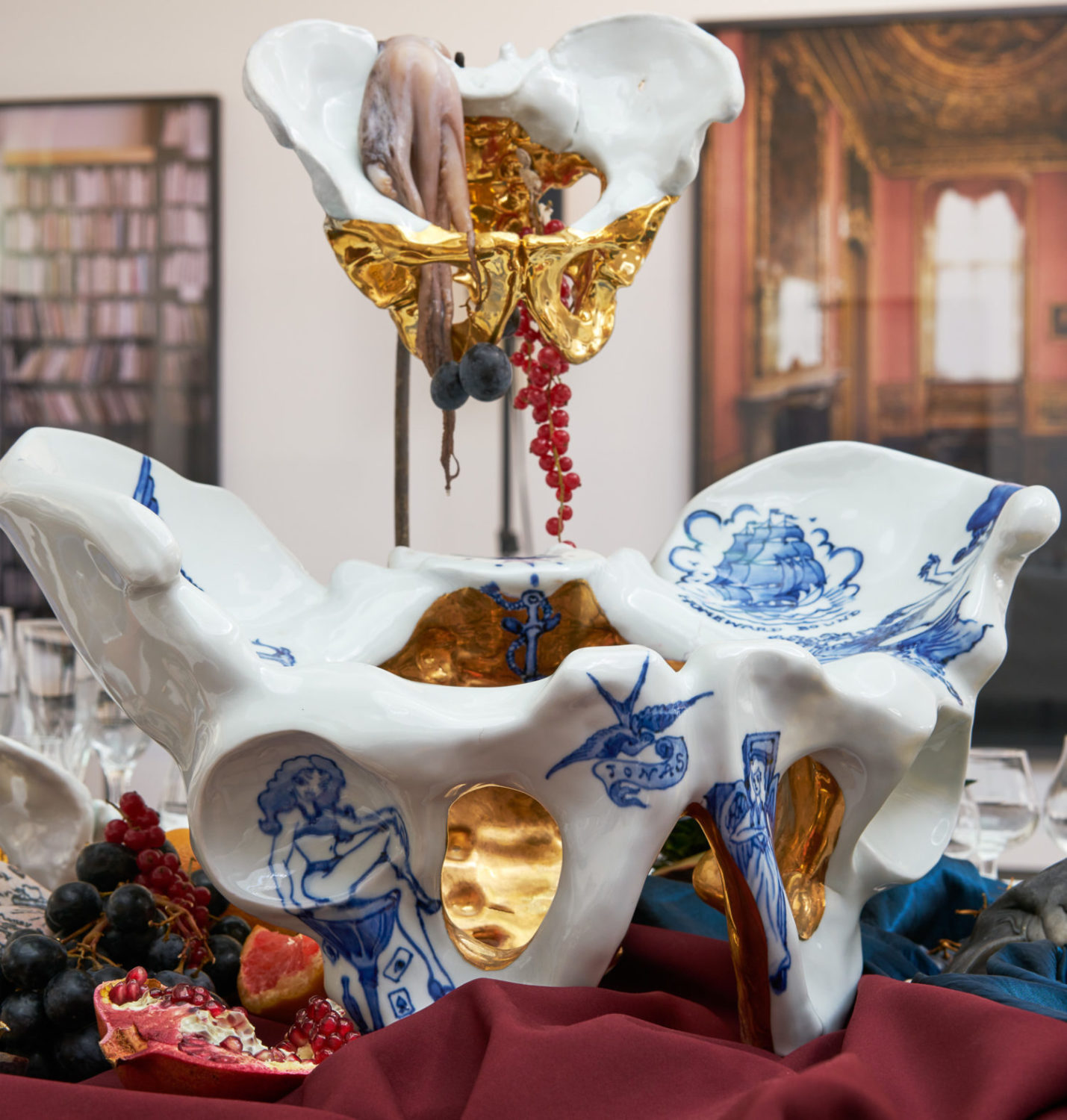
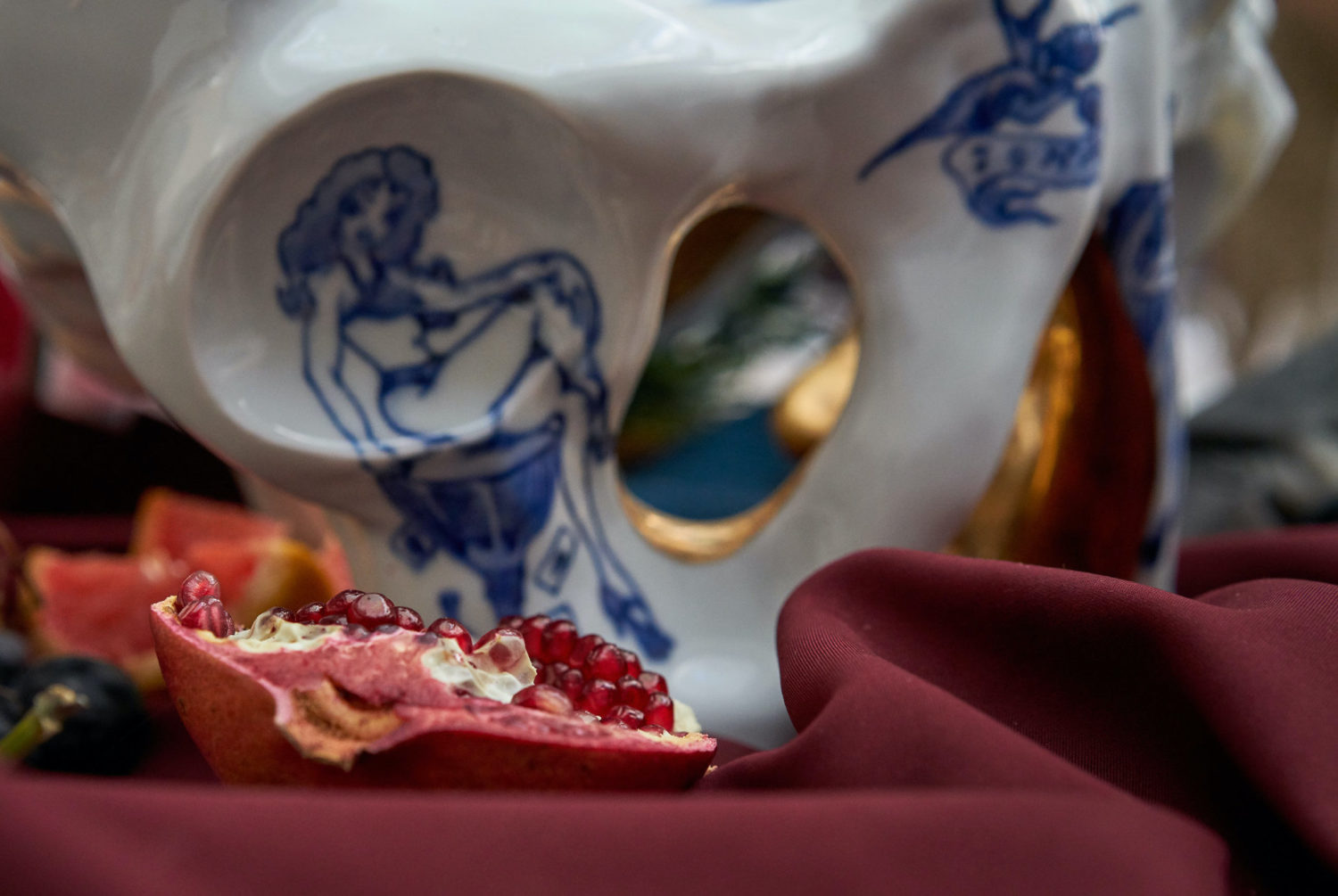
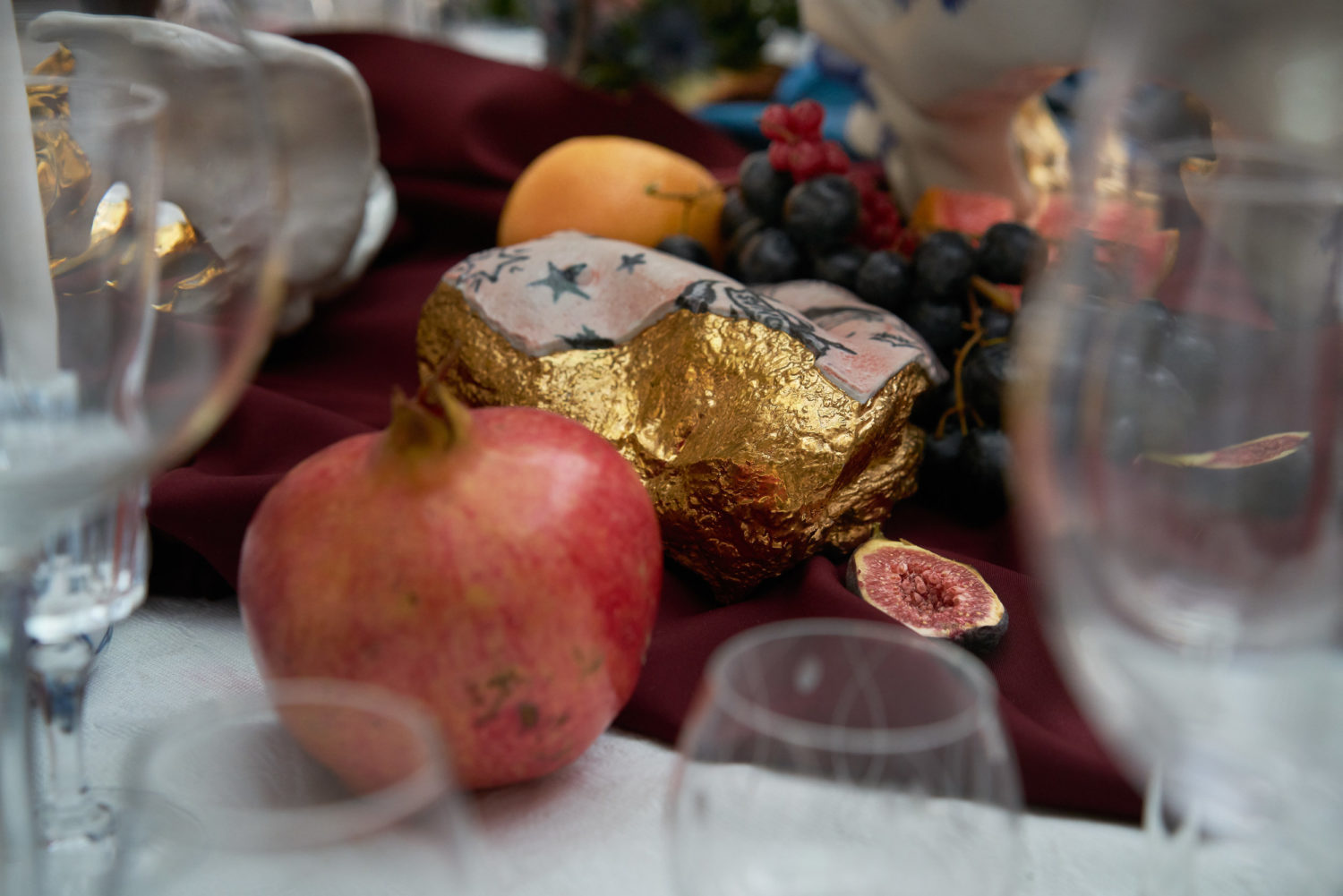
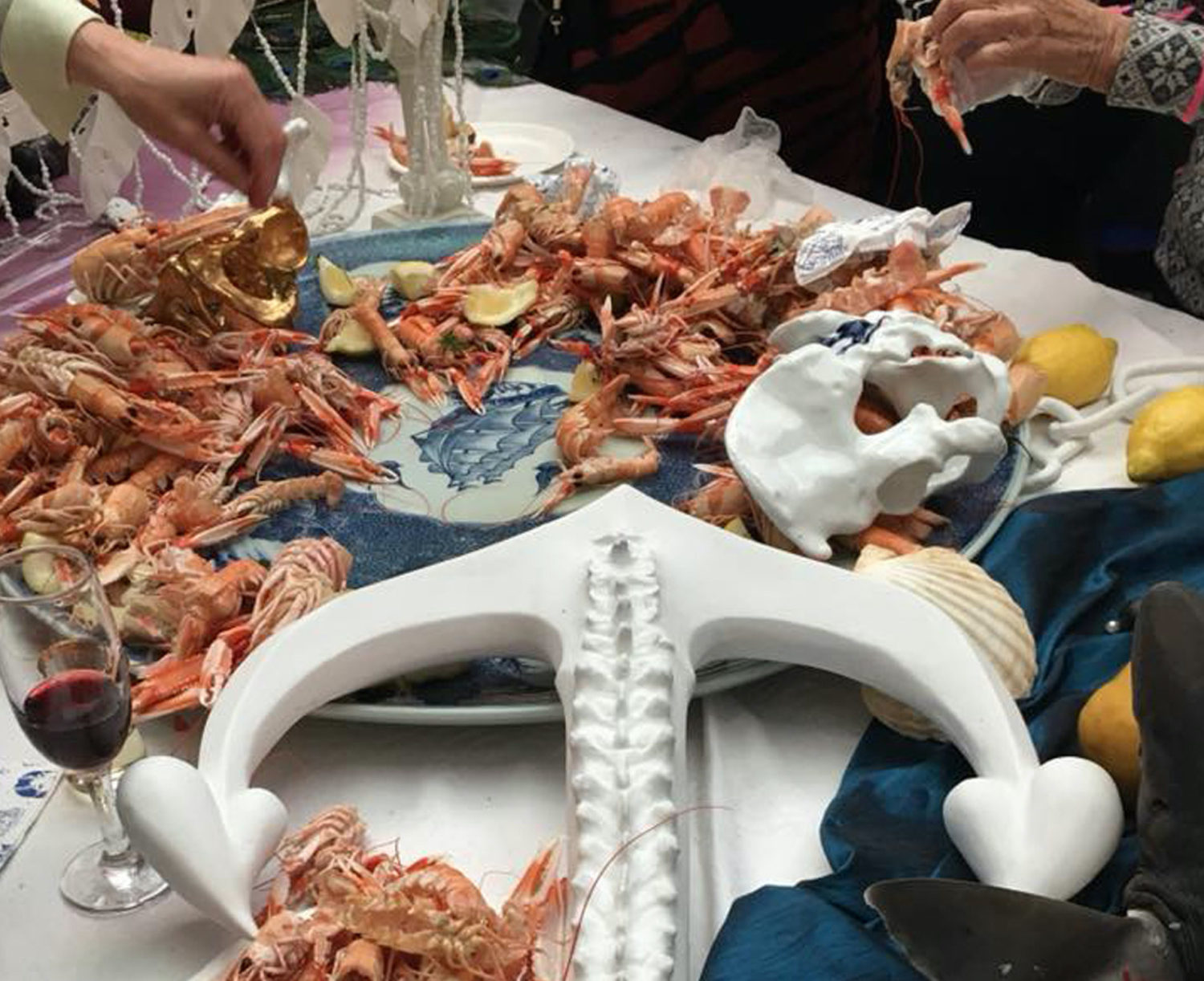
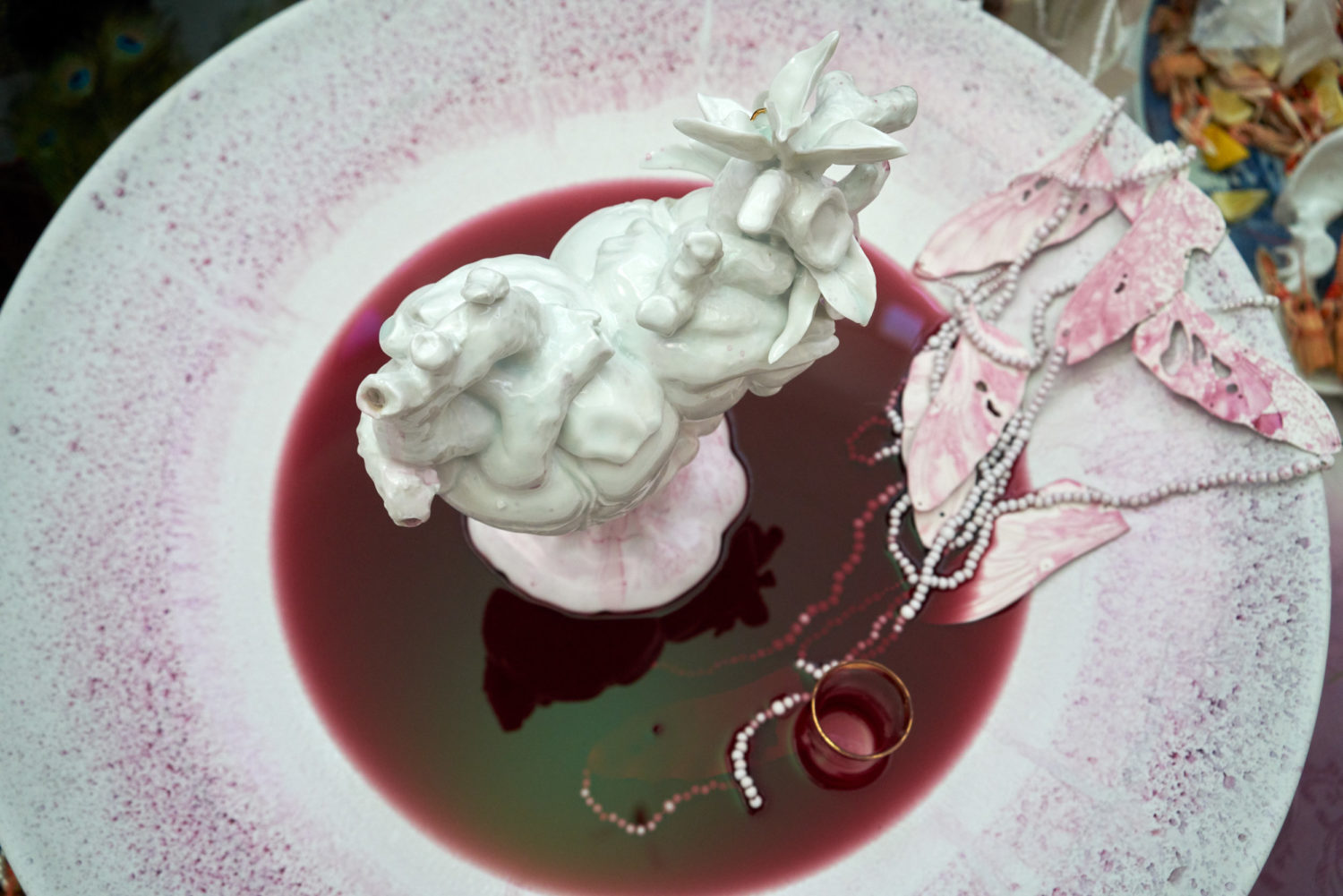










The guests come together for a friendly meal during which the dinner table becomes a platform for the exchange of thoughts. When the food is eaten, the symbolism and expressions of the artworks on the gigantic dinnerwares are discovered.
The project started in 2015 and since then, new concept and artworks have been continuously developed and expanded through performance dinners and exhibitions. The project aims to reach out to groups or segments in our society that are not necessarily familiar with visual arts. Throughout this project I also like to examine and experience the use of Soft Power in both a cultural and political exchange.
Learn More about the artist here.
Richard Notkin Has Something To Talk About
KANSAS CITY. We felt as though it might be a good time to highlight the politically charged work of Richard Notkin. Sherry Leedy Contemporary Art recently hosted his exhibition titled We Stumble on… New and Recent Artwork.
Richard Notkin’s teapots, ceramic sculptures and tile murals are visual explorations into social and political commentary. Through the 1960’s, 70’s and 80’s, when large-scale abstract expressionist vessels and gestural ceramic sculptures were the rage in contemporary American ceramics, Notkin worked with a tightly controlled, high degree of craftsmanship and attention to detail.


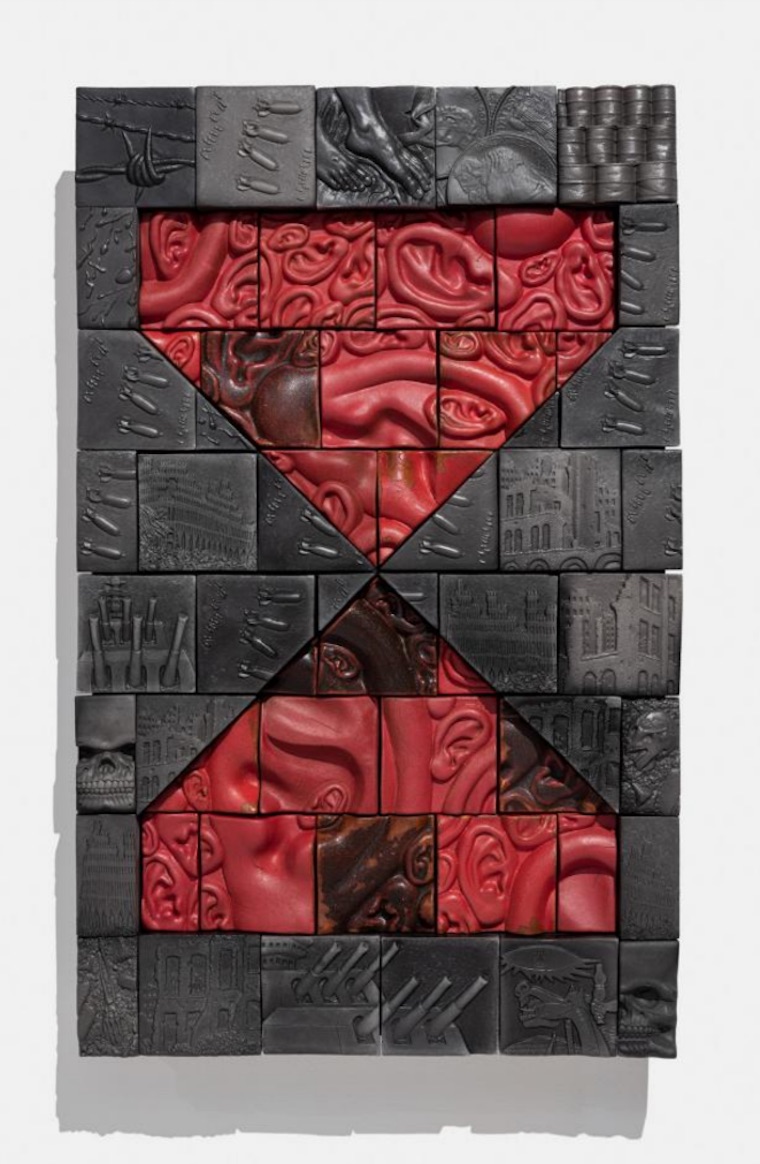



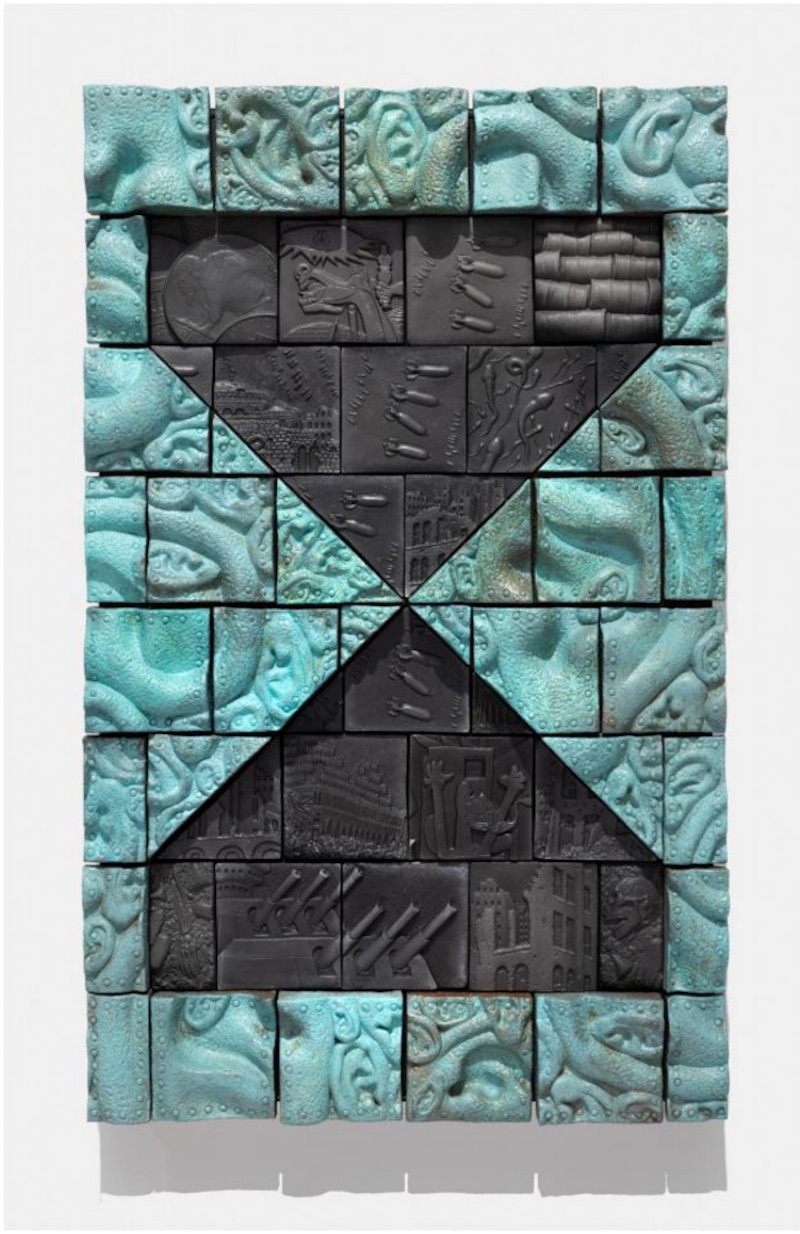








He is perhaps most known for his series of unglazed stoneware teapots, inspired by the remarkable Yixing wares of China (circa 1500 AD to the present), but consciously maintaining a separate cultural identity, “reflecting the current dilemmas of our contemporary human civilization.”
Notkin feels a particular sense of urgency to continue making after such a long and storied contribution to the field:
I find curious parallels in the cult-like rise of Mussolini’s Fascist Italy and the situation we find ourselves embroiled in today in our own nation. As a young student in the early 1950’s, I was taught by Holocaust survivors in my family’s synagogue to always be aware, alert and, most of all, active. For over five decades, my art has been my form of activism, my megaphone, my soapbox, if you will. As such, I will let the pieces — and their titles — speak for themselves.
Learn more about this show from Issuu.
A Handsome Drifter Indeed…
BERKELEY. The UC Berkeley Art Museum and Pacific Film Archive (BAMPFA) is well into hosting Ron Nagle for his exhibition Handsome Drifter, which is scheduled to run through March of 2021. Brian Boucher has a snynopsis of the show for Artnet:
“Diabolically beautiful.” “Ridiculously seductive.” “Subversively beautiful.” Ron Nagle’s tiny, abstract sculptures inspire his fans to reach for their most expressive language to evoke their abundant appeal. (Those are raves, respectively, from Dave Hickey, Ken Johnson, and Apsara DiQuinzio.) His ceramic sculptures, only inches to a side, pack colors and textures into packages that contain visual excitement galore.
“Ron Nagle: Handsome Drifter,” on view at the UC Berkeley Art Museum and Pacific Film Archive, presents work mostly from the new millennium, capping five decades of ceramics that are alluring and repellent, deeply weird, and utterly bewitching. Nagle worked primarily in the medium for decades, after honing his techniques in California in the ‘50s with the legendary Peter Voulkos (one of Nagle’s great inspirations, along with the painter Giorgio Morandi). He started off with shapes that echoed cups—clay’s equivalent the nude in painting, as Peter Schjeldahl has put it—and vases, but soon moved into abstract forms in tandem with his friend, inspiration, and fellow clay artist, Ken Price.


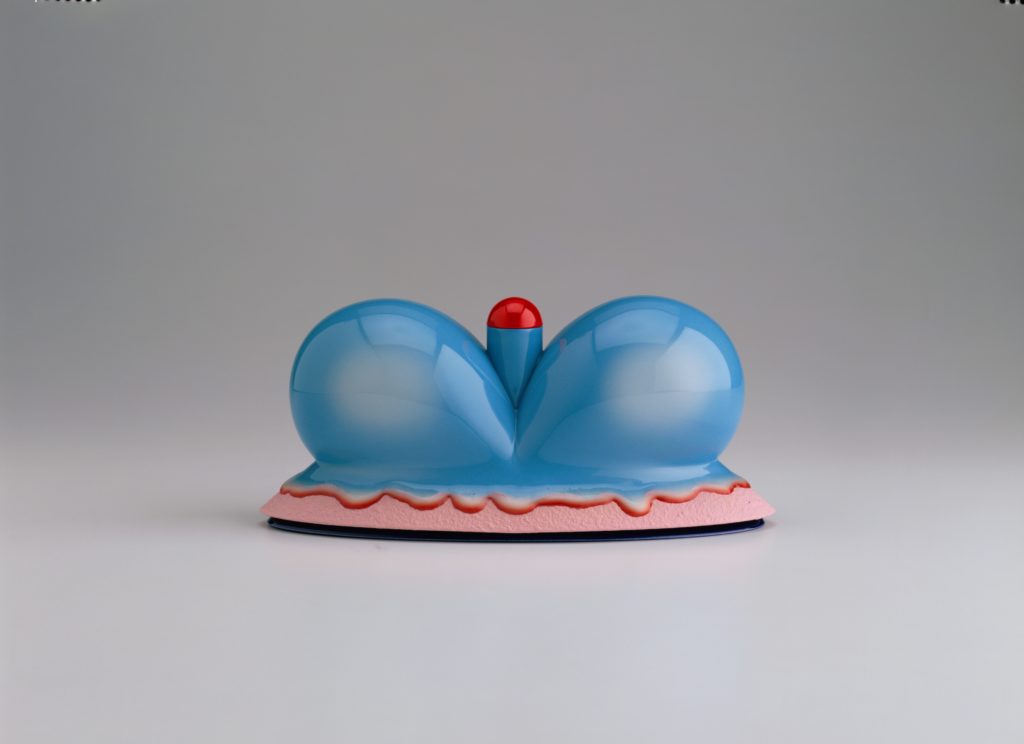








Despite his brilliance, Nagle long found himself consigned to the margins of the art world, his work classified as craft. Lately, ceramics have come into vogue, with artists like Price, Arlene Schechet, and Betty Woodman getting the spotlight and younger artists like Sterling Ruby and Zachary Leener adopting the medium. Nagle notched a major lifetime achievement when he was included in Massimilano Gioni’s Venice Biennale in 2013. Since then, the blue-chip Matthew Marks Gallery has mounted its own biannual shows of the artist. At the same time, in the last decade or so, Nagle has introduced other materials from the world of craft, like epoxy resin and polyurethane. Nagle seems to be acting out what he calls his “contempt for purity in ceramics”—just as the medium is having its moment in the sun. It’s a characteristically perverse turn.
Nagle has also been a songwriter and musician for as long as he’s been making sculptures; performers like Jefferson Airplane, Sammy Hagar and Barbra Streisand have recorded his compositions. Berlin-based critic Jan Verwoert, in a stunning essay in the BAMPFA exhibition catalogue, draws out the similarities between the two modes of creation; both in song and in sculpture, the artist achieves poetry, flawless structures, and surprise in compact formats. “This is the only guy so far who has been able to kind of creep into my head,” said Nagle, approvingly, of Verwoert’s take on his dual practices. (For anyone seeking the aural equivalent of Nagle’s ceramic inventiveness: His newest release is Introducing…The Many Moods of Ron Nagle, while his 1970 solo album Bad Rice has just been re-released in expanded form by Omnivore Records.)
John Mason Finds Strength in Form
NEW YORK. A bold collection of geometric sculpture by John Mason is on display at the Park & 75 Gagosian Gallery. The gallery offers some detailed context on the impact Masons work has had on the field.
One of the most visionary ceramic artists of the last century, Mason brought his medium into conversation with Abstract Expressionism by extending the physical and spatial properties of clay. He began his career on the West Coast in the 1950’s, as part of a group of artists who studied with the pioneering ceramist Peter Voulkos at the Otis Art Institute, Los Angeles. Mason and his contemporaries challenged conventional ideas about ceramics, making large, abstract, subversive works. Mason worked at scale, his wall reliefs and expressionistic sculptural works matching the ambitious painting and sculpture of the era. In his Los Angeles studio, which he shared for a time with Voulkos, they began employing industrial techniques and technologies: humidifiers from fruit packing plants, which allowed clay to stay pliable for longer periods of time; heavy-duty dough mixers; and a custom-built kiln that enabled him to fire works six feet in height, often using up to two tons of clay at a time.


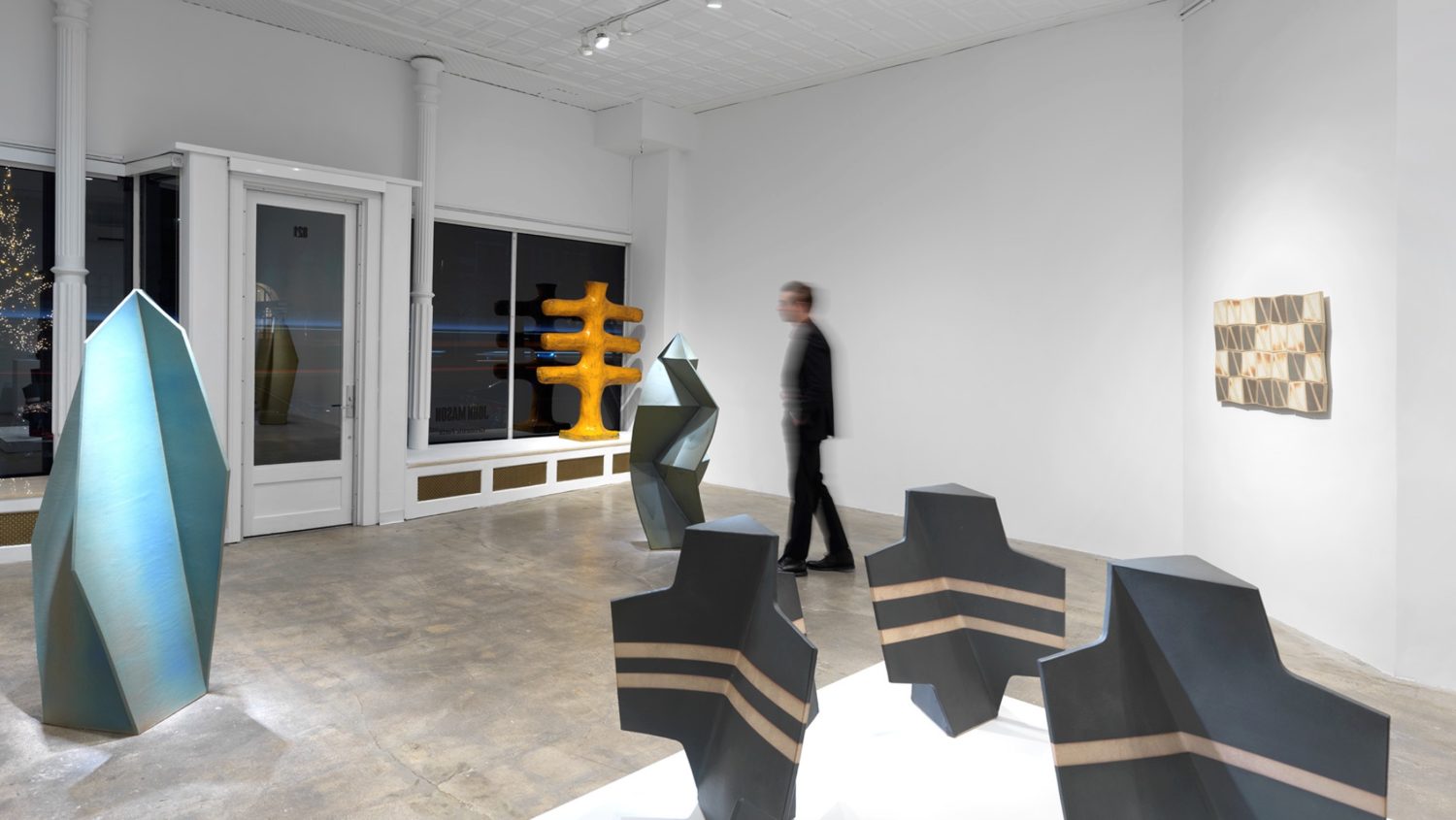

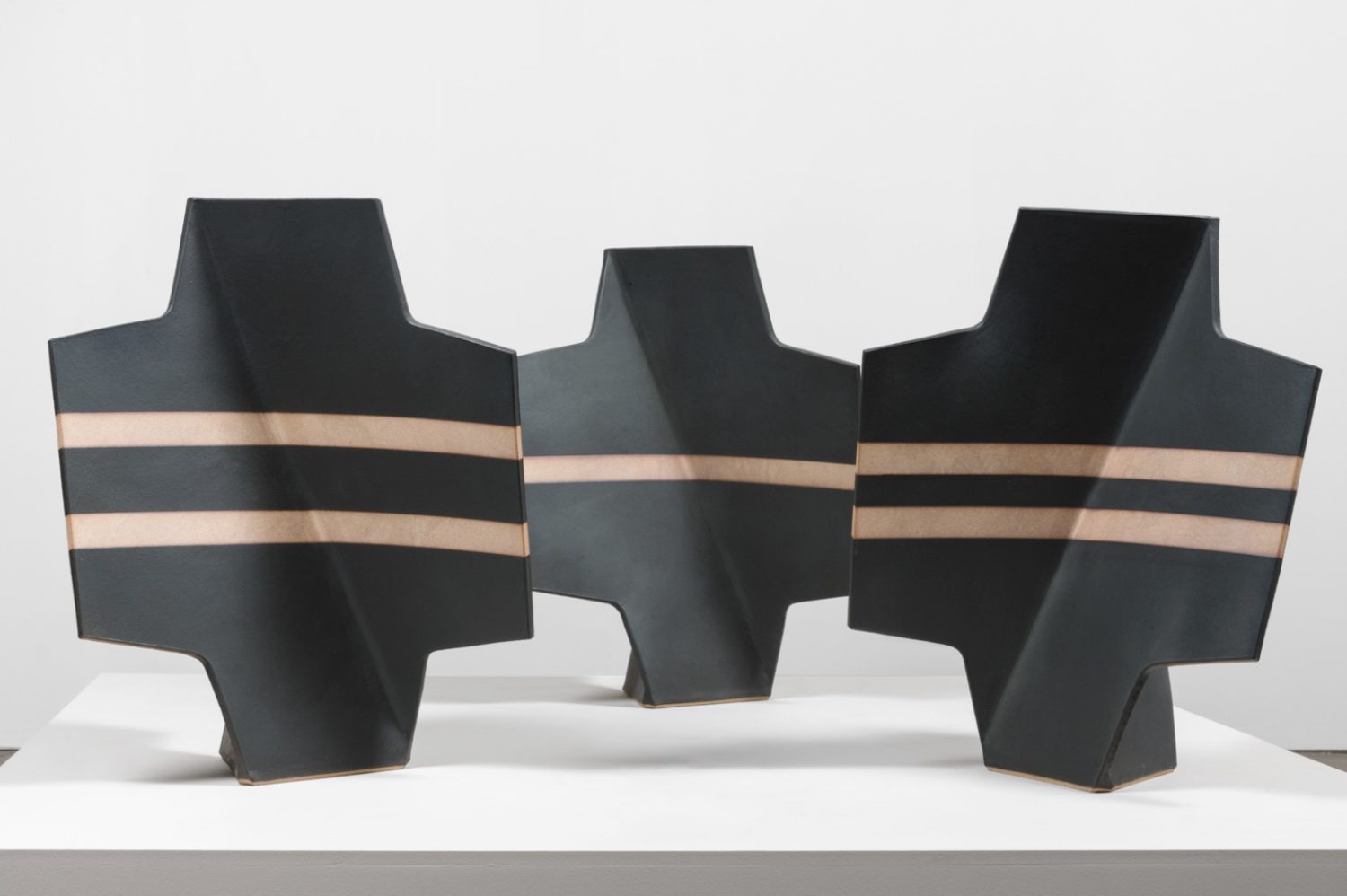












The works in this exhibition, which span Mason’s early career to the years preceding his death at age ninety-one in 2019, attest to the range and vocabulary of his innovation and experimentation in clay. Standing almost six feet tall, Orange Cross (1963) is glazed in a rich hue that recalls the desert landscape of Nevada, where Mason grew up. These earthy tones, along with shades of blue reminiscent of an open sky, recur throughout his work. Orange Cross encapsulates many of Mason’s evolving concerns, including tensions between geometry and materiality, and open and closed forms. Smaller works demonstrate his ability to shift his scope in terms of form and scale. His “orbs” are made from geometric circles and right angles, fitting together in modular formation with no single beginning, end, top, or bottom.
Often cited as a contributor to the “revolution in clay,” Mason changed the perception of ceramics, mixing Western and Eastern influences. The material result is something completely sui generis and hard to trace—untethered to a single genre or movement, yet related to many.